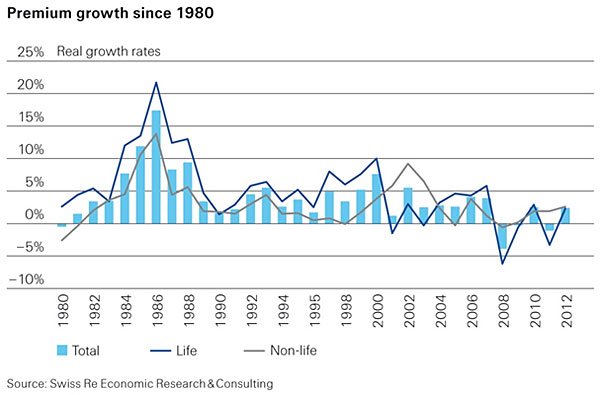The year 2012 saw global insurance premium growth resume, after 2011 saw a contraction, according to the latest Sigma report from reinsurer Swiss Re. Premiums are set to continue to grow at a moderate pace, with non-life and emerging markets leading the way. This could lead to new opportunities for the insurance-linked securities (ILS) and reinsurance markets.
The report, published today, looks at life and non-life insurance premium growth trends over recent years, where growth is most evident and looks ahead to try to ascertain whether growth will continue. In recent years economic conditions around the world have weighed on insurance premium growth, but Swiss Re is optimistic that premium growth will improve further in the near term.
In 2012 non-life premiums grew by 2.6%, while life grew by 2.3%. Overall the volume of premiums expanded but events in Europe, China and India held this back. Global life insurance premiums grew to $2.621 trillion in 2012, after a contraction of 3.3% in 2011. Global non-life premiums grew to $1.992 trillion. Total global premiums written increased by 2.4% in real terms in 2012 to $4.613 trillion.
The chart below shows premium growth trends since 1980:

Insurance premium growth trends since 1980
Emerging economies are driving much of the non-life premium growth and Asian insurance markets, followed by a shift more towards Africa, are the rising stars Swiss Re sees over the next decade or so. In emerging markets, non-life premiums expanded by 8.6% in 2012, a greater increase that in 2011 when premiums expanded by 8.1%.
“Premium growth expectations for the short-term remain below pre-crisis trends. In life, the expansion in emerging markets will likely accelerate as insurers in China and India adapt to the new regulatory environment, but the weakness in Western Europe will dampen developments in advanced markets. The non-life side is more positive since the sector will benefit from the strong economic performance of emerging markets and selective rate increases in advanced markets. However, rate increases will likely be moderate given the prevailing surplus capacity in the markets,” said Mahesh Puttaiah, one of the authors of the Sigma study.
Kurt Karl, Swiss Re’s Chief Economist, commented; “The rise in importance of emerging Asia in the global economy and insurance markets witnessed over the past 20 years is set to continue for at least another decade. However, demographic patterns suggest that by 2062, Asia’s share in the world population will actually decrease from 60% to 53%, mainly due to the developments in China, where the working age population will start to contract from 2018. At the same time, Africa’s population share is projected to increase from 15% currently to roughly 27%. This positions Africa well, from a demographic point of view, to become an important part of the global insurance markets over the next fifty years.”
It is the growth of these emerging market insurance premiums which will eventually present a huge opportunity to the insurance-linked securities (ILS), reinsurance convergence sectors and, of course, third-party capital providers looking for new investment opportunities. As premium growth continues there will be a growing need for reinsurance protection and retrocession, the traditional markets may not be the best positioned to take advantage of this and may not have the capacity required on their own.
Given the current growth of the reinsurance convergence and ILS space, if this continues, it may put these sources of alternative reinsurance capacity in prime position to capitalise on global premium growth. It’s often said that a market needs to be 60% to 70% reinsured (in an ideal scenario).
Up to 2023 Swiss Re’s report suggests that life premiums are forecast to grow by 8% annually. This will lead Asian markets to double their share of the life insurance market to around 19% and China alone will have life premiums of $650 billion. The U.S. will remain the largest life market with $1 trillion of premiums, followed by Japan with $700 billion and China not far behind.
In non-life, growth up to 2023 is expected to be robust as more economies modernise and population moves into urban living. The Asian regions contribution to non-life premiums is expected to grow to 17%, with China set to become the worlds second largest non-life market with premiums of $480 billion. By 2023, seven emerging economies are expected to be among the twenty largest non-life insurance markets.
That kind of growth will see demand for catastrophe reinsurance grow significantly, and ILS and alternative reinsurance structures are set to position themselves to take an ever-increasing piece of this market. Of course, we still need to see accelerated development of risk models to support this, but the growth of these markets, and premium volumes worldwide, can only result in new opportunities for ILS and third-party capital to take advantage of.
You can read Swiss Re’s press release on the Sigma report here. Download a copy of the report in PDF format here.
We covered a similar report from reinsurer Munich Re in May: As primary insurance grows, reinsurers and capital markets need to be ready.
 View all of our Artemis Live video interviews and subscribe to our podcast.
View all of our Artemis Live video interviews and subscribe to our podcast.
All of our Artemis Live insurance-linked securities (ILS), catastrophe bonds and reinsurance video content and video interviews can be accessed online.
Our Artemis Live podcast can be subscribed to using the typical podcast services providers, including Apple, Google, Spotify and more.































